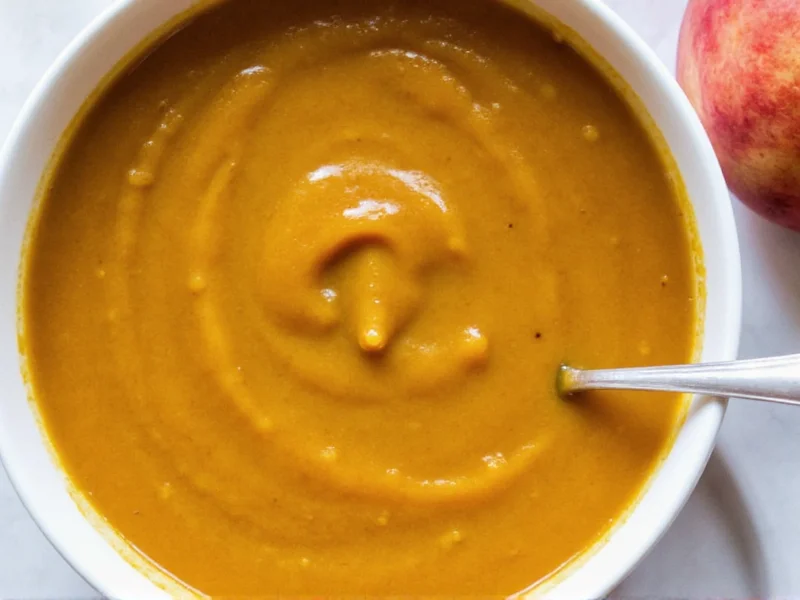The Perfect Harmony of Fall Flavors
Butternut squash apple soup represents one of autumn's most harmonious culinary pairings. The natural sugars in both ingredients caramelize beautifully when roasted, developing complex flavor notes that canned alternatives simply cannot replicate. Professional chefs consistently recommend using heirloom varieties like 'Waltham' butternut squash and tart 'Granny Smith' or 'Honeycrisp' apples to achieve the ideal sweet-tart balance without added sugar.
Essential Ingredients and Quality Considerations
Selecting high-quality ingredients makes the most significant difference in your butternut squash apple soup results. Look for squash with deep beige skin and heavy weight relative to size—these indicate denser, sweeter flesh. Avoid specimens with soft spots or cracks, which suggest overripeness or damage. For apples, choose firm varieties that maintain structure during cooking while contributing bright acidity to cut through the squash's richness.
| Ingredient | Quality Indicators | Recommended Quantity |
|---|---|---|
| Butternut squash | Deep beige color, heavy weight, no soft spots | 2 lbs (about 1 medium squash) |
| Apples | Firm texture, bright color, no bruising | 2 medium (about 1 lb) |
| Onion | Firm, dry outer skin, no sprouting | 1 medium yellow onion |
| Garlic | Firm cloves, papery skin intact | 2-3 cloves |
| Vegetable broth | Low sodium, clear ingredients list | 4 cups |
Step-by-Step Preparation Method
While many butternut squash apple soup recipes call for boiling ingredients, professional chefs achieve superior flavor through roasting. Preheat your oven to 400°F (200°C). Peel and cube the squash into 1-inch pieces, toss with olive oil, salt, and pepper, then spread on a parchment-lined baking sheet. Core and slice the apples into wedges and arrange alongside the squash. Roast for 35-40 minutes until both are caramelized and tender.
Simultaneously, sauté diced onion in olive oil over medium heat until translucent (about 8 minutes). Add minced garlic and cook for 1 minute more. Transfer roasted squash and apples to a large pot with the sautéed aromatics, then add vegetable broth and your choice of spices. For classic flavor, use 1 teaspoon each of ground cinnamon and nutmeg plus 2 sprigs of fresh sage. Simmer uncovered for 15 minutes to allow flavors to meld.
Remove sage sprigs, then carefully blend the soup using an immersion blender until completely smooth. For restaurant-quality texture, strain through a fine-mesh sieve, pressing with a ladle to extract maximum flavor. Adjust seasoning with salt, pepper, or a touch of maple syrup if needed. The soup should have a velvety consistency that coats the back of a spoon.
Flavor Variations and Dietary Adaptations
This versatile butternut squash apple soup base accommodates numerous dietary preferences and flavor profiles. For a vegan version that maintains creaminess without dairy, substitute coconut milk for heavy cream or add 1/4 cup raw cashews during blending. Those following a paleo diet can enhance richness with a tablespoon of ghee stirred in at the end.
Spice variations dramatically transform the soup's character. For Moroccan-inspired flavor, add 1 teaspoon each of cumin, coriander, and smoked paprika plus a pinch of cayenne. For an earthy autumnal profile, incorporate 1/2 teaspoon of fresh thyme and a whole star anise during simmering. Many professional chefs recommend finishing with a squeeze of fresh lemon juice to brighten flavors just before serving.
Serving Suggestions and Pairings
Butternut squash apple soup achieves its full potential when paired thoughtfully. Serve hot in pre-warmed bowls to maintain ideal temperature. Classic garnishes include toasted pumpkin seeds, a drizzle of coconut milk, or fresh sage leaves fried in olive oil until crisp. For textural contrast, add a sprinkle of croutons made from sourdough bread.
This soup pairs beautifully with crusty artisan bread for dipping or a simple green salad with apple cider vinaigrette. For a complete meal, serve alongside roasted chicken or a hearty grain salad featuring quinoa and roasted root vegetables. The soup's natural sweetness complements dry ciders or medium-bodied white wines like Pinot Gris.
Storage and Reheating Best Practices
Proper storage ensures your homemade butternut squash apple soup maintains quality. Cool the soup completely before transferring to airtight containers. Refrigerated soup stays fresh for 4-5 days. For longer storage, freeze in portion-sized containers with 1/2 inch headspace for expansion—properly frozen soup retains quality for up to 3 months.
When reheating, gently warm the soup over medium-low heat, stirring occasionally. Avoid boiling, which can cause separation or alter texture. If the soup has thickened during storage, add small amounts of broth or water to reach desired consistency. Never reheat the soup multiple times, as this degrades both flavor and nutritional quality.
Troubleshooting Common Issues
Even experienced cooks encounter challenges with butternut squash apple soup. If your soup tastes too sweet, balance with acidity—add lemon juice or apple cider vinegar one teaspoon at a time. For soup that's too thin, simmer uncovered to reduce liquid or create a slurry with 1 tablespoon cornstarch mixed with 2 tablespoons cold water.
When dealing with stringy texture, ensure you've removed all fibrous strands from the squash before cooking. For optimal smoothness, blend while hot (using caution) and consider straining through a fine-mesh sieve. If flavors seem flat, enhance with umami-rich ingredients like a Parmesan rind during simmering (remove before blending) or a dash of soy sauce.











 浙公网安备
33010002000092号
浙公网安备
33010002000092号 浙B2-20120091-4
浙B2-20120091-4